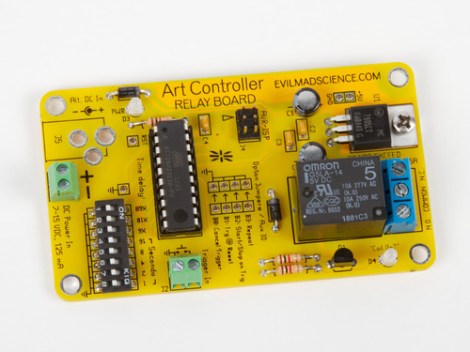
Meet the Art Controller, a new dev board available over at Evil Mad Scientist Laboratories. It provides a drop-in solution for switching higher voltage loads (but not mains). The thing we like most about it is the ability to alter a switching delay without reprogramming the firmware.
The board uses an ATtiny2313 for control. It’s fed regulated 5V power from the on-board 7805 linear regulator. The relay can handle a 24V DC or 40V AC load, which is targeted at an audience that needs electronic switching for art-related devices but doesn’t want the hassle of designing a circuit every time. This offers a single shot, or repeat action, with that bank of DIP switches selecting a delay from once every second, to every 31 hours. It can get its initial trigger from anything that can pull a pin low, like a button, or a coin acceptor.
Keep this in mind. The open source nature of the project means it could come in handy as a reference design.















The relay says 10A 277VAC. “Not for mains”? What’s the problem? Did they run low side traces too close for you?
Whoops, accidentally hit the report button. Sorry!
I think this is because most people buying this (“artsy” people) aren’t certified to work with mains voltage. They’re probably doing this to cover their asses.
There is no isolation. It can’t be sold for mains power.
newbie question, but what would need to be changed to isolate the mains above and beyond the relay?
Judging by the schematic and relay datasheet the only place mains power would be is between this 3-screw connector and a relay. Other than 6 pads there isn’t anything live to touch, so unless (and I’m pretty sure that’s the case here) I don’t know about some over-protective USA law I can’t really say why I couldn’t be sold for use with mains power, at least in Poland where I live. I wouldn’t sell it without any enclosure to an end customer (you couldn’t slap CE mark on it as it is now) but as a module to be build into something? I don’t see any problem with that.
sigh, so many people think a relay has to be isolated. Relays exist in millions of microwave ovens that have zero isolation other than the relay itself because it isn’t needed. Isolation isn’t needed because relays have isolation, there are huge air gaps between any switched load and the coil being powered by the relay controller. The only way you get switched voltage inside a relay back to the switching device is if the relay catastrophically fails and good brands like omron don’t do this except 1 in several million, even then they fail by not switching the load or leaving the load switched on, they don’t send voltage back to the controlling device.
Take apart a relay and see for yourself how far apart the switching parts and any connection to the coil are or better yet read the datasheets from omrons site, 15KV isolation isn’t enough for some people I guess.
low voltage switches (input from user) needs to be isolated from the HV 120V ect. Here (USA) if the mains is addicentally coupled to the switch via a trace too close, or some clamping failure the 120V could be delivered to the user. Its dangerous too say the least. Having an opto isolator or some magnetic/capacitive coupling would be a fix, however im not sure that it was designed for that.
I’m not sure an optoisolator will help with a random track being shorted.
Still curious I looked in on EMSL and they say that they don’t rate it for mains usage because it is not in a box that keeps out little fingers. Of course relays provide isolation. They never connect the coil to the contacts!
They don’t rate it for mains usage because they haven’t paid to have the board tested and approved by UL, CE, or whoever else.
I have worked on designs identical to this, and they have been certified for mains connection. The relay is already UL and VDE listed, so it should be fine. The only remaining issue is creepage and clearance of the high voltage leads relative to the low voltage circuitry,
I’d not hesitate to hook this into a mains circuit. It would nee to be securely mounted in a grounded metal box, of course. I’m fairly sure that is exactly what the designers intended.
Every time a relay comes up, it’s amusing to see how many people don’t understand it provides isolation; and suggest slapping an optocoupler on it. Hee haw.
I am very novice when it comes to electronics, but i have learned much over the last few weeks on this site and others. trying to build an electronic shooting gallery, coin-op,built into a trailer. So running across this cool unit the other day got me excited!I ordered one right then and there to do some experimenting. Im hoping an IR signal will trigger this so i can relay 12-24VDC to power pneumatic solenoids for the target animations and sound. any tips or advise on this project?